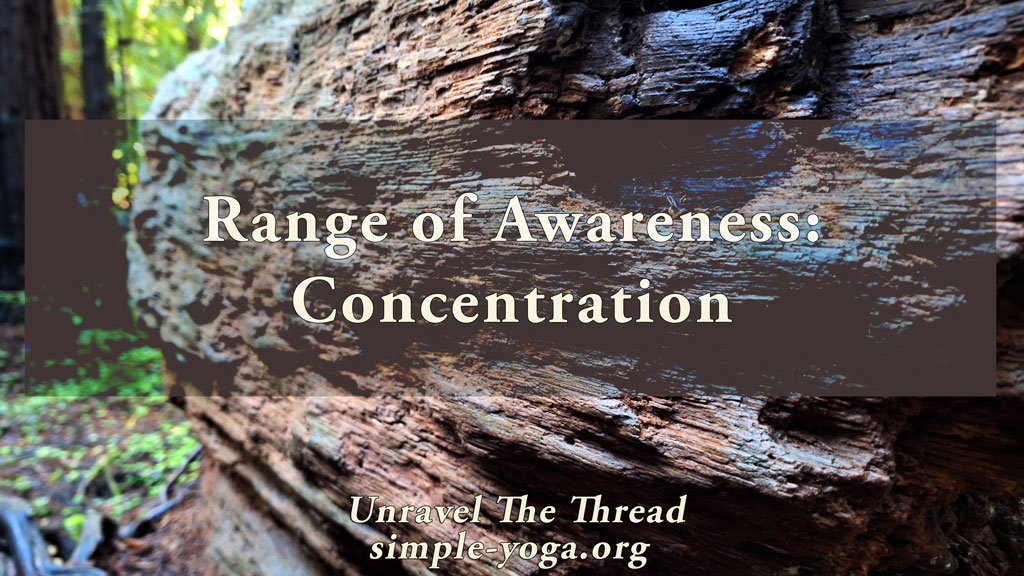
Range of awareness and experiences
March 12, 2024
Range of Awareness – Open awareness
April 8, 2024
Range of awareness and experiences
March 12, 2024
Range of Awareness – Open awareness
April 8, 2024Range of awareness – Concentration

Range of awareness: Concentration
In previous episodes we have talked about Range of Awareness as a simple recognition that most, if not all, natural events are actually processes rather than a single action that occurs in an instant. We have used the example of the transitions between day and night, where the twilight period is not instantaneous, but a gradual progression of events filled with great subtlety. We have suggested that the idea of Range of Awareness can invite us to notice many of these subtleties in a process, thus increasing our awareness by developing our sensitivity, responsiveness, and appreciation of life as it manifests in ourselves, in everything around us, and in our interconnectedness. We also suggested earlier that it might be useful to explore how to embody the idea of range of awareness, for example, by exploring the range between single point focus and open awareness. Today we will explore bringing our awareness into a single point of focus through a deceptively simple technique.
Remember that at the beginning of Chapter Three of The Yoga Sutras, Patañjali identifies two stages in the meditation process; the first stage is the sixth of the eight limbs, concentration (dharana), our ability to bring our mind into a single focus. The second stage is meditation (dhyana), when we can maintain our concentration on the same object with minimal effort.
When we try to concentrate on a single thing, most of us find that our minds are easily distracted. For example, we find that our mind soon starts thinking about what it usually thinks; it may be the activities we were engaged in in the moments before we began the concentration exercise; it may be that our mind starts thinking about what is next in our day; or it may be that we start going through our mental list of things to do. This exercise strengthens our ability to concentrate. This ability only becomes stronger if we keep returning to our chosen focus. In this concentration exercise, we are going to pay attention to our natural breath and we are going to count three rounds of natural breath over and over again. Quite simple. Let’s begin.
As usual, in a room with fewer distractions, find a comfortable position that enables you to be relaxed while attentive. Become familiar with the sounds and noises coming from outside. Then bring your attention to the sensations in your body, using this as an opportunity to release unnecessary tension. Then offer yourself your undivided attention. Invite yourself to be curious about your natural breathing. Notice what sensations arise as your body inhales and then feel if the sensations are similar or different as your body exhales. Sometimes we may feel the need to control our inhalation and exhalation, but here we are just witnessing our body breathing, it does this unconsciously all day, every day. Once you feel some familiarity with your natural breathing process, we will begin to count three rounds of breathing, feel a natural inspiration and the expiration that follows, then mentally count one. Feel the next natural inhalation and exhalation and mentally count two. Directly experience this in-breath and its subsequent out-breath and mentally count three. As your body continues to breathe at its own rhythm, count every three breaths, starting again at one. That’s it. Keep it simple. You may find that your mind gets distracted and loses count. This is not a problem. Just come back to feeling your breath and counting three times. ….Some times you may find that you continue to count past three, no problem, once you realize that you got distracted, return to counting three rounds of breathing…Keep everything simple and relaxed….Just continue to feel your breath as clearly as you can and count each round of inhalation and exhalation…It is normal for our minds to start thinking about other things. As soon as you notice the distraction, bring your attention back to counting, and you will strengthen your ability to concentrate. Enjoy each breath and count it…
Now let go of the counting and place yourself in a very relaxed position. Notice the effects of this practice in your breathing, in your body and in your mind. All of us get distracted. It may be helpful to become aware of the things that distract our minds. We might find that our minds tend to go to their familiar places, such as something we are working on, something we are planning, or something we are worried about. … We can notice these tendencies, and when we are distracted, we can choose to think about these things, or we can continue to improve our ability to focus.
What would happen if you tried this practice for a few days? What would you notice? Would it become easier to focus? Could this help our mind take a break from its constant planning and doing? What does it feel like when our mind focuses on just one thing?
If you prefer, you may listen to the podcast:
This is an excerpt from the book Unravel the thread: Applying the ancient wisdom of yoga to live a happy life
If you find Simple-Yoga.org and Unravel the thread useful, consider supporting my labor with a donation, you may also donate using PayPal or Venmo. Thank you!
